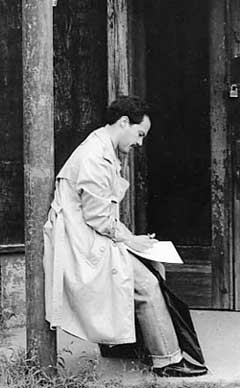 Appearance, Flight, Return
Appearance, Flight, Return
Recitative, Chorale, Disappearance
Scherzo/Minuet, Trio (Double-Double Duo), Minuet/Scherzo
Vision, Variations, Reflection
commissioned and premiered by the Carolina Chamber Symphony, Robert Franz, Music Director
One of the richest traditions of Western art has been the gradually unfolding development of symphonic form. For over two hundred years, composers have explored their imaginations through this orchestral medium, measuring their musical thoughts and shifting cultural environments against an ever-expanding standard. Beginning with Beethoven, any composer’s first symphony is not merely a self-contained statement, but also a response to a host of other statements, couched in terms that are at once deeply personal and infinitely referential.
When considering my first step into this intimidating fray, I began by looking for links to connect the traditional forms to the most prevalent issues in my life and music. The results of this search are immediately apparent in the subtitles for each movement, which seek a common ground between dramatic/poetic imagery and classical structures. Thus, the first movement bears the heading “Appearance, Flight, Return,” which describes the three sections (exposition, development, recapitulation) of a classical first movement. The word “flight” for the middle section has three layers of meaning: First, the music takes flight from the end of the previous passage, suddenly moving faster and in a more linear texture. Second, “flight” describes the compositional technique used, as the French word for flight is fugue: this passage is a strict fugue derived from the characteristic four-note figure that links the various sections in “Appearance.” Finally, “fugue” is a psychological term for a specific type of amnesia, and loss of memory is a recurrent theme in my work, and an important expressive element in this piece.
In “Return,” the four-note transitional figure that linked the various components of “Appearance” and dominated “Flight” is omitted, a gesture that both intensifies the contrasts and provides a musical parallel to the subtext of fragmented recollection.
The second movement treats the absence of memory in a more direct, developmental way. The opening section features a static double bass recitative against dense harmonies in the rest of the orchestra. Midway through, the texture thins out, and a quiet chorale emerges in string harmonics. This chorale is gradually overrun by an accumulation of rapid woodwind figures, becoming barely audible by the conclusion.
The same process takes a more whimsical turn in the next movement, which presents a battle between the two most common ABA forms: the minuet and the scherzo. In the first “A” section, the agile scherzo is overtaken by the lumbering minuet, but, when “A” returns, it is the minuet that gradually succumbs to the scherzo.
The “B” section in a symphonic third movement is traditionally referred to as a “trio.” Here it receives the tongue-in-cheek designation of “double-double duo” because it features a pair of double-reed canonic couples: Oboe/English horn and Bassoon/Contrabassoon.
The final movement subtitle, “Vision, Variations, Reflection,” is again a reference to both dramatic flow and classical structure. The “vision” is a simple harmonic progression – the basic progression that underlies the entire symphony – which is subjected to four variations. The piece concludes with a brief coda, or epilogue, in which the second-movement chorale is recalled.
ORDER SYMPHONY NO. 1:
- score and parts: American Composers Editions
“The evening’s freshest encounter was Dillon’s First Symphony, written brilliantly for its string choirs and demonstrating that every modern symphony doesn’t require steroidal brass and percussion forces. Dillon argues his case principally through strings and woodwinds, flavoring the mix with a pair of horns. Propulsive energy defines the first and third movements, which possessed exceptional structural rigor and harmonic richness. Even more remarkable was the second movement — a slow, ghostly sequence with slightly freakish double-bass solos and small, plaintive exclamations from the oboe. The entire symphony testifies to the composer’s compelling, innate soulfulness.”
– Andrew Adler, Louisville Courier-Journal